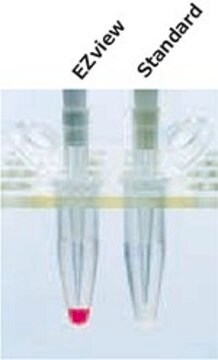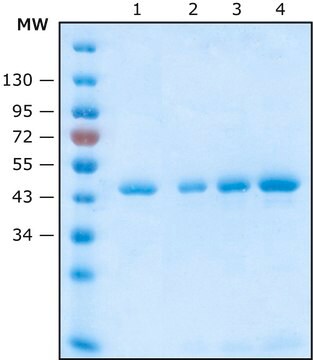11815016001
Roche
Anti-HA Affinity Matrix
from rat IgG1
Sinonimo/i:
affinity matrix, anti-ha
Autenticatiper visualizzare i prezzi riservati alla tua organizzazione & contrattuali
About This Item
Codice UNSPSC:
12352203
Prodotti consigliati
Origine biologica
rat
Livello qualitativo
Coniugato
agarose conjugate
Forma dell’anticorpo
purified immunoglobulin
Tipo di anticorpo
primary antibodies
Clone
3F10, monoclonal
Stato
slurry
Confezionamento
pkg of 1 mL (settled resin volume)
Produttore/marchio commerciale
Roche
Isotipo
IgG1
Sequenza dell’epitopo
YPYDVPDYA
Capacità
2-8 nmol/mL binding capacity
Temperatura di conservazione
2-8°C
Categorie correlate
Descrizione generale
Anti-HA High Affinity antibody (clone 3F10) recognizes the 9-amino acid sequence YPYDVPDYA, derived from the human influenza hemagglutinin (HA) protein. This epitope is also recognized in fusion proteins that are derived from mammalian, bacterial, and yeast expression vectors, regardless of its position (N-terminal, C-terminal or internal)
Specificità
Anti-HA High Affinity antibody (clone 3F10) recognizes the 9-amino acid sequence YPYDVPDYA, derived from the human influenza hemagglutinin (HA) protein. This epitope is also recognized in fusion proteins that are derived from mammalian, bacterial, and yeast expression vectors, regardless of its position (N-terminal, C-terminal or internal).
Immunogeno
Amino acids 98-106 from the human influenza virus hemagglutinin protein
Applicazioni
Following immunoprecipitation or purification, the tagged protein of interest may be analyzed by:
- Western blotting using the Anti-HA antibody
- Silver staining (or similar protein stain)
- In coimmunoprecipitation.
Use Anti-HA Affinity Matrix for:
- Immunoprecipitation of HA-tagged proteins from mammalian, bacterial, and yeast cell extracts
- Affinity column purification of HA-tagged proteins from crude protein extracts
Caratteristiche e vantaggi
- Achieve enhanced specificity and reduced cross-reactivity of Anti-HA High Affinity.
- Use nondenaturing conditions for elution of your HA-tagged protein of choice.
- Purify even rarely expressed HA-tagged proteins.
- Highly specific to YPYDVPDYA.
- Suitable for purification of proteins containing HA-epitop as N-terminal, C-terminal or internal fusion.
- Applicable with crued cell extracts from mammalian, bacterial and yeast expression systems.
Qualità
Each lot of Anti-HA Affinity Matrix is tested for its ability to purify a HA-tagged protein expressed in stably transfected cells from a crude mammalian extract. The immunoprecipitate is analyzed by western blot using Anti-HA, High Affinity antibody.
Stato fisico
1 ml settled resin of Anti-HA Affinity Matrix in PBS containing 0.09% sodium azide (w/v); 2 ml suspension equals to 1 ml bed volume. One plastic column with top and bottom caps is included.
Risultati analitici
Yield of 9 nmol purified protein/ml affinity matrix was determined using a whole-cell bacterial extract containing expressed HA-tagged bacterial alkaline phosphatase.
Altre note
For life science research only. Not for use in diagnostic procedures.
Non trovi il prodotto giusto?
Prova il nostro Motore di ricerca dei prodotti.
Codice della classe di stoccaggio
12 - Non Combustible Liquids
Classe di pericolosità dell'acqua (WGK)
WGK 1
Punto d’infiammabilità (°F)
does not flash
Punto d’infiammabilità (°C)
does not flash
Scegli una delle versioni più recenti:
Possiedi già questo prodotto?
I documenti relativi ai prodotti acquistati recentemente sono disponibili nell’Archivio dei documenti.
I clienti hanno visto anche
Francisco José Taberner et al.
BMC cell biology, 11, 47-47 (2010-07-01)
The control of the subcellular localization of cell cycle regulators has emerged as a crucial mechanism in cell division regulation. The active transport of proteins between the nucleus and the cytoplasm is mediated by the transport receptors of the beta-karyopherin
Geetha Hewawasam et al.
Molecular cell, 40(3), 444-454 (2010-11-13)
Cse4 is a variant of histone H3 that is incorporated into a single nucleosome at each centromere in budding yeast. We have discovered an E3 ubiquitin ligase, called Psh1, which controls the cellular level of Cse4 via ubiquitylation and proteolysis.
Abdirahman Abdi et al.
Cellular and molecular life sciences : CMLS, 67(19), 3355-3369 (2010-06-29)
Over the last decade, several protein kinases inhibitors have reached the market for cancer chemotherapy. The kinomes of pathogens represent potentially attractive targets in infectious diseases. The functions of the majority of protein kinases of Plasmodium falciparum, the parasitic protist
David A Hubert et al.
The EMBO journal, 22(21), 5679-5689 (2003-11-01)
The Arabidopsis protein RPM1 activates disease resistance in response to Pseudomonas syringae proteins targeted to the inside of the host cell via the bacterial type III delivery system. We demonstrate that specific mutations in the ATP-binding domain of a single
Stephen C Kales et al.
PloS one, 9(1), e87116-e87116 (2014-01-28)
The Cbl proteins (Cbl, Cbl-b, and Cbl-c) are a highly conserved family of RING finger ubiquitin ligases (E3s) that function as negative regulators of tyrosine kinases in a wide variety of signal transduction pathways. In this study, we identify a
Protocolli
Anti-HA Affinity Matrix Protocol & Troubleshooting
Il team dei nostri ricercatori vanta grande esperienza in tutte le aree della ricerca quali Life Science, scienza dei materiali, sintesi chimica, cromatografia, discipline analitiche, ecc..
Contatta l'Assistenza Tecnica.











